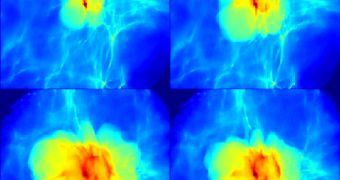Results of computer simulations carried out at the Nagoya University, Japan show that, in the outcome of the tremendously energetic event that gave rise to what we now call the universe, ripples propagating through matter caused clouds of gas to condense and collapse, so as to form the first objects to shine visible light. These protostars would have eventually grown into stars massive enough to initiate nuclear fusion reactions in their cores and fuse hydrogen into heavy elements like carbon and iron, which is also suggested by telescope observations of very distant objects.
This indicates that massive stars should have existed much earlier in the history of the universe, although until now nobody attempted to create a model regarding the first stages of the formation of these objects. "Previous works probed up to only intermediate stages where only gas blobs or dark matter clumps are formed," said Naoki Yoshida of Nagoya University, lead author of the study.
The new model on the other hand, reveals in close detail how the star evolves from the early stages to the point where it is able to initiate nuclear fusion reactions. The understanding of this process is imperative, considering that these stars created the heavy elements that several billion years later gave rise to life on Earth.
"If we want to understand how things came about and why they look the way they do now, we have to go back in time and understand how stars looked when they first began to form," said Lars Hernquist of the Harvard-Smithsonian Center for Astrophysics, part of the research team detailing the new findings.
Evidence suggests that these massive bright stars started shinning light in the universe as soon as 200 million years after the Big Bang event, ending a period in the universe known as the dark ages. As with all massive stars burning hydrogen at incredibly fast rates, these first stars eventually exploded into supernovae, spreading the heavy elements they produced throughout the universe.
The simulations were able to reveal how hydrogen and helium atoms along with dark matter were able to bundle together and form objects as small as one percent of the mass of the Sun, representing the cores of the Population III stars. However, they cannot show what happens after the star initiates nuclear fusion and starts turning into a main sequence star. The computer power required to model this step is simply unavailable at this moment.
"Previously what people did was stop the simulation when the gas was collecting within a scale of roughly the size of the solar system. They were not able to zoom in on the central core," said Avi Loeb of the Harvard-Smithsonian Center for Astrophysics.
"It is like laying the foundation of a skyscraper. In the simulations that we had before, we started at the first or second floor and we built a hundred-floor skyscraper. Now we can get in at the ground floor," said Volker Bromm of the University of Texas, Austin, while revealing that the new study could help astrophysicists understand the dynamics of modern stars.

 14 DAY TRIAL //
14 DAY TRIAL //